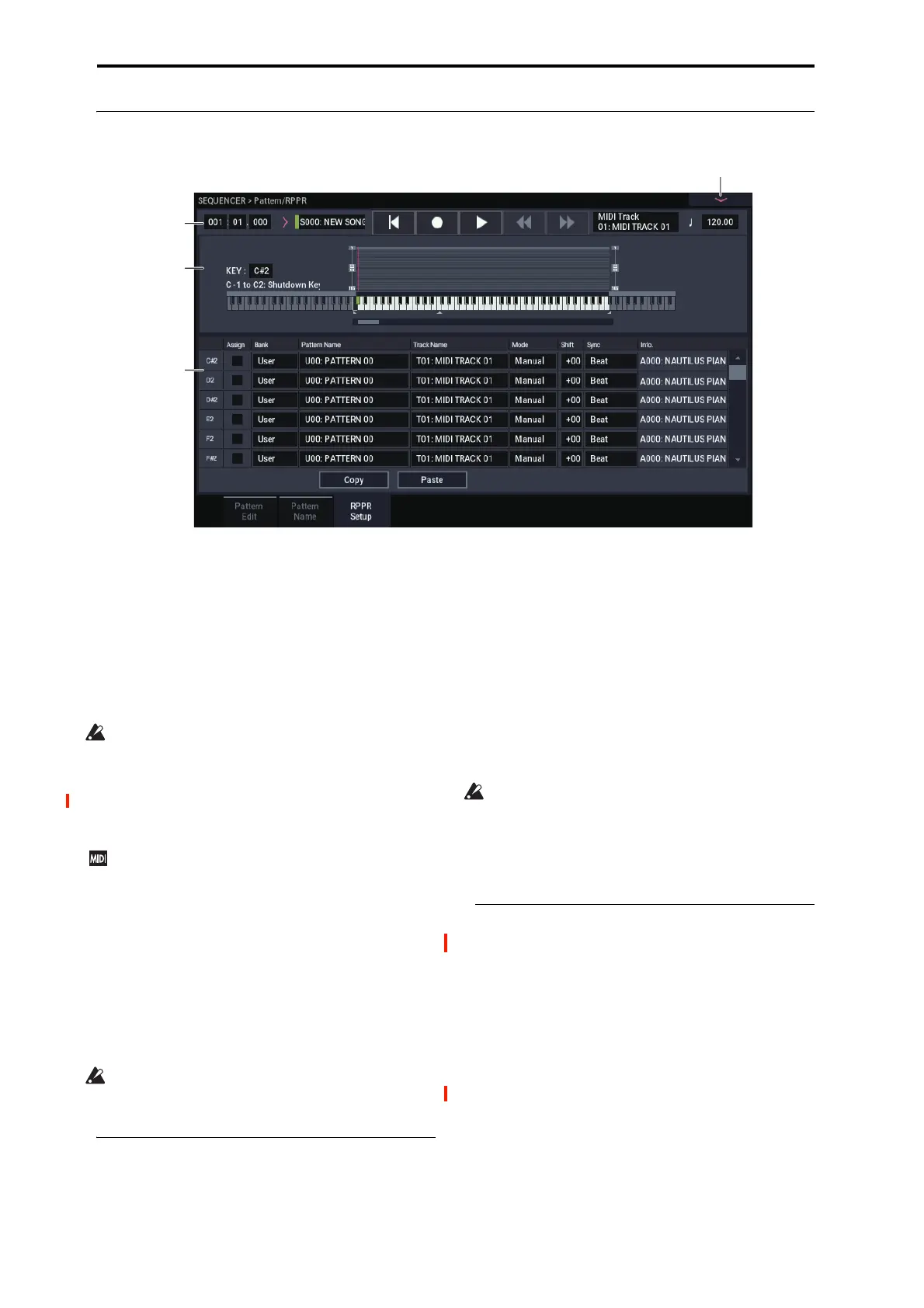SEQUENCER mode
504
5–3: RPPR Setup
Here you can make settings for the RPPR (Realtime Pattern
Play/Recording) function. RPPR lets you assign patterns to
individual keys, and then playback patterns simply by
pressing individual notes on the keyboard. This performance
can be recorded in real-time.
For each song, you can assign either a preset pattern or a user
pattern to each of the 72 keys in the range C#2–C8. For each
key, you can specify the pattern, track number, and how the
pattern will be played.
Keys used to play patterns via RPPR cannot be used for
Arpeggiator. If RPPR is on, keys to which a pattern is not
assigned will play the program of the track that’s selected
in Track Select. In this case, ARP will operate if
Arpeggiator A or B is assigned to the track and turned on.
Also, notes generated by ARP will not trigger the RPPR
function.
When Local Control is OFF (“Local Control On” Global
1–1a), the keyboard will not trigger RPPR pattern
playback. Notes received at MIDI IN on the channel of
the track currently selected by Track Select will trigger
patterns. If you have recorded only the trigger notes on an
external sequencer and wish to use the playback from the
external sequencer to trigger RPPR patterns on
NAUTILUS, set Local Control OFF.
If you want the note data generated by RPPR to be
recorded by the external sequencer, set Local Control
ON, and turn off the echo back function of the external
sequencer. See “Local Control On settings” on page 928.
In the RPPR Setup page, RPPR is turned on
automatically. This will be the same result as when the
RPPR check box (0–1a) in each page is checked.
5–3a: Song Select, Track Select, Tempo
Song Select [00…199: name]
Selects the desired song. The RPPR settings will be assigned
to the song you select here.
Track Select [MIDI Track01…MIDI Track16,
Master Track, Audio Track01…Audio Track16]
When you play a key that is not assigned to RPPR, it will
sound using the settings of the track that’s selected in Track
Select. Use this to select the track that you want to play
together with RPPR, or to audition a pattern before you
assign it. The program bank, number, and name of the
selected track is shown at the right.
Each RPPR pattern will begin playing when you press the
assigned key, regardless of the Track Select setting. It will
sound using the settings of the track selected in “Track
Name.”
The Master Track and Audio Track 01–16 settings are
ignored. The last-selected MIDI Track 01–16 will be
used.
(Tempo) [040.00…300.00, EXT]
Specifies the playback tempo of the patterns. (0–1a)
5–3b: KEY, Keyboard & Assigned
Graphics
KEY (Key Select) [C#2…C8]
This specifies the key to which you want to assign the RPPR
pattern. You can also set the KEY by holding down the
ENTER button and playing a note on the keyboard, or by
simply touching one of the parameters in the RPPR Setup
table in the bottom half of the display.
Keyboard & Assigned Graphics
This shows the selected key, and the keys to which a pattern
has been assigned by the RPPR function. See diagram
below.

